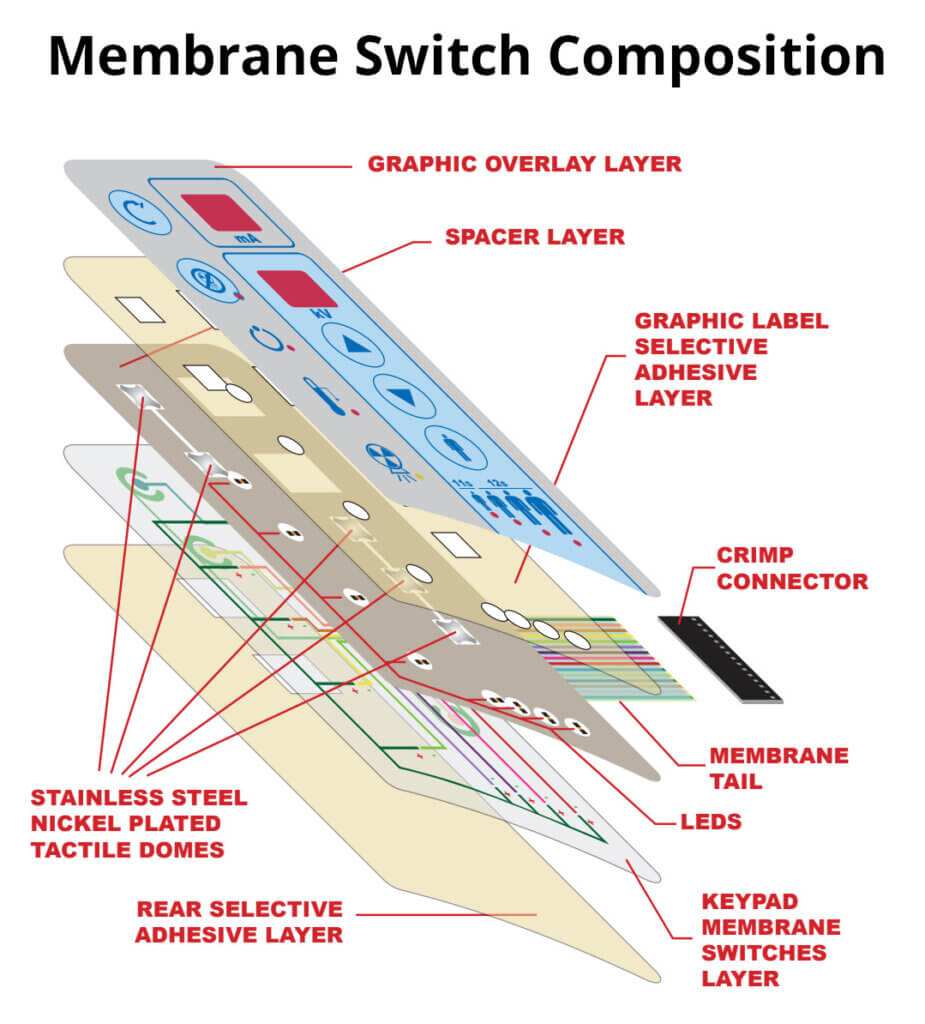Top Features to Look for in a High-Quality Membrane Switch
Top Features to Look for in a High-Quality Membrane Switch
Blog Article
Recognizing Membrane Switches Over: The Key to Sturdy and Trusted Controls

What Are Membrane Layer Buttons?
Membrane switches are an innovative remedy in the realm of interface innovation, incorporating capability and design perfectly. These gadgets work as a user interface in between customers and digital systems, incorporating numerous parts right into a compact format. Usually built from versatile, slim layers of materials, membrane layer buttons are created to react to touch, making it possible for customers to connect with equipment and digital tools properly.
The key components of a membrane layer button consist of a printed circuit layer, graphic overlay, and a spacer layer that stops unplanned activation. The visuals overlay can be customized to mirror brand name identity or user preferences, improving looks while making certain use. Membrane layer switches are typically utilized in numerous applications, consisting of medical devices, consumer electronic devices, and commercial devices, owing to their sturdiness and resistance to environmental aspects such as moisture and dirt.
Among the essential advantages of membrane layer switches is their ability to withstand damage, making them suitable for high-traffic atmospheres. Additionally, they are light-weight and need minimal room, permitting ingenious designs in item development. Overall, membrane layer switches stand for a effective and functional choice for contemporary electronic user interfaces, weding innovation with user-centric design principles.
Exactly How Membrane Switches Work
The operation of membrane changes joints on a simple yet efficient device that converts user input into digital signals. When a customer presses the button, the top layer warps, enabling a conductive component in the circuit layer to make call with a corresponding conductive pad on the underside of the graphic overlay.
The style of membrane layer buttons can differ, yet they frequently integrate domes or responsive components to give feedback to the user, improving the total experience - membrane switch. The products made use of in membrane switches, such as polyester or polycarbonate, add to their durability and resistance to environmental elements, including wetness and dust. The published circuits are typically encapsulated, which safeguards them from wear and tear over time.
Benefits of Membrane Buttons

Furthermore, membrane layer buttons are recognized for their resilience. Built from robust materials, they are resistant to dust, wetness, and physical wear, which substantially expands their life-span contrasted to typical mechanical buttons. This durability makes them particularly suitable for high-traffic environments and applications requiring longevity.
Another substantial advantage is the convenience of cleansing and upkeep. The smooth surface area of membrane switches minimizes dust buildup and is often unsusceptible spills, making them ideal for setups that call for regular sanitization.
Additionally, membrane switches offer a structured account, causing a thinner style that can be integrated right into numerous gadgets without adding mass. This attribute not only enhances the visual appeal yet likewise contributes to a more ergonomic item style.
Applications of Membrane Buttons
User-friendly and versatile, go right here membrane layer switches find applications throughout a large range of sectors, consisting of medical tools, customer electronics, and commercial devices. In the medical area, these switches are integral to tools such as diagnostic equipment, person tracking systems, and infusion pumps, where integrity and simplicity of cleaning are important. Their capability to endure rough environments and keep performance makes them suitable for such applications.

In customer electronics, membrane layer buttons are used in items like microwaves, washing devices, and remotes - membrane switch. Their sleek style permits intuitive individual interfaces, boosting the overall individual experience while giving sturdiness and resistance to damage
Industrial devices additionally takes advantage of membrane switches, specifically in control panels for machinery and automation systems. These switches use defense against dust and wetness, making certain regular performance in challenging atmospheres. Moreover, their personalized attributes permit manufacturers to tailor them to particular operational requirements, improving performance and capability.
Selecting the Right Membrane Layer Change
When choosing a membrane layer button, it is vital to take into consideration numerous aspects that affect efficiency and viability for certain applications. The main factors to consider include environmental conditions, responsive responses, resilience, and style specifications.
First, evaluate the operating environment; switches exposed to moisture, chemicals, or extreme temperatures require particular materials to ensure long life and capability. Next off, examine the requirement for tactile comments. Relying on customer communication, some applications may take advantage of a responsive action to verify activation, while others may prefer a non-tactile design for visual reasons.
Resilience is an additional important element; membrane layer switches need to be created to hold up against frequent use, effects, and abrasion. Guarantee the selected button can endure the anticipated lifecycle, my response especially in high-usage useful source scenarios.

Final Thought
Finally, membrane switches function as necessary elements in the design of reputable and resilient control systems throughout different industries. Their portable design, incorporated with robust construction and adjustable features, boosts individual communication while making sure longevity sought after environments. The adaptability of membrane switches over allows for customized solutions that satisfy specific functional demands, strengthening their value in contemporary innovation. As industries proceed to evolve, the significance of incorporating effective membrane layer button solutions can not be overemphasized.
Membrane layer switches over stand for a crucial element of contemporary user interface layout, mixing capability with strength in various applications.Membrane switches are a sophisticated service in the realm of individual interface innovation, integrating performance and layout flawlessly. Typically constructed from flexible, thin layers of materials, membrane layer buttons are made to react to touch, making it possible for customers to connect with equipment and digital tools properly.
The layout of membrane layer buttons can differ, yet they commonly include domes or responsive components to supply responses to the customer, improving the overall experience.In conclusion, membrane changes offer as important elements in the style of sturdy and reliable control systems throughout different industries.
Report this page